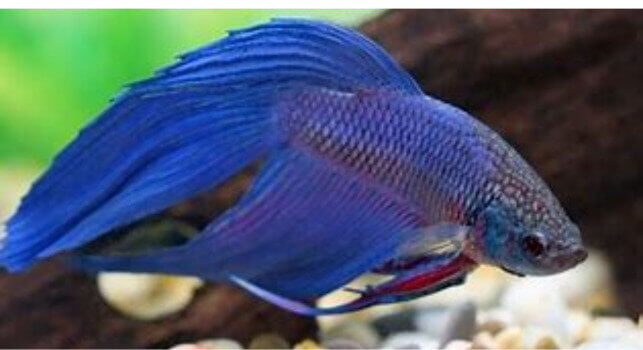Bettas, also known as Japanese Fighting Fish, are famous for their pretty colors and different types of fins and tails. People have bred Bettas in specific ways to get different colors and tail shapes. Every year, there are even more kinds of Bettas. People don’t all agree on how many types of Bettas there are, but many think there are around 70 or even more.

Out of all these types, the Veiltail is very popular and easy to make more of. Even though they are familiar and easy to find, they are still really beautiful, just like the other types of tails. Keep reading to learn more about the Veiltail Betta fish.
Table of Contents
A Quick Guide to Veiltail Bettas
The Veiltail Betta (Betta splendens) is a popular and captivating freshwater fish species belonging to the family Osphronemidae. Known for their elaborate finnage and vibrant colors, Veiltail Bettas are a favorite among aquarium enthusiasts. Here are some quick facts about them:
| CategorSpecies Name | Betta splendens |
| Family | Osphronemidae |
| Color | Multiple; typically turquoise and bright royal blue |
| Lifespan | Up to 5 years |
| Care Level | Easy |
| Behavior & Temperament | Peaceful |
| Compatibility | Peaceful or semi-aggressive |
| Food and Diet | Carnivores |
| Size | Up to 3 inches |
| Tank Setup | Freshwater; floating water plants |
| Tank Size (Minimum) | 4 gallons |
Veiltail Betta Overview
A Veiltail Betta fish is a popular type of Betta fish kept in home aquariums. It used to be really popular, but now some other special types of Betta fishtails, like Crowntail or Halfmoon, have become more popular.

Even though its popularity has gone down, people still like to breed Veiltail Bettas because it’s easy. They’re not judged in competitions anymore because they’re so common, but some fish breeders still want to keep them around because they’re pretty.
How Much Do Veiltail Bettas Cost?
VeilTail Bettas are really common and can be made to have babies without much trouble. Because of this, they’re not very expensive. If you get them from different places and they’re not very old, you might pay as low as $2 or at most $6.
On the other hand, the fancier kinds of Bettas can be sold for hundreds or even thousands of dollars, just to compare. Bettas are a type of fish that have been selectively bred over many years to create unique color combinations and patterns.
As a result, they are generally inexpensive, but some rarer varieties or those with unusual traits can be sold at a premium.
Some Bettas have been bred to have longer fins or tails, and this can add to their collector value. Others may have unique color combinations that are hard to replicate, making them highly sought-after.
Typical Behavior & Temperament
People who take care of VeilTail Betta fish say that these fish are more social and nice compared to other kinds of Betta fish. They like to move their tails and swim around to see their owners. Even though Betta fish are known for being aggressive, VeilTail Betta fish are calm and peaceful. However, if two male fish are together, they might fight to protect their space.
Appearance & Varieties
Veiltail Bettas have a special kind of tail that is long and flowy. It hangs down from the back, near their fin. These Bettas can be found in many different colors because of the strong gene they have. This makes it easy to have babies (breed). The male Bettas are usually more colorful and stunning, while the females have shorter tails and are not as bright.
How to Take Care of Veiltail Bettas
VeilTail and other Betta fish are simple to look after. When they have good living conditions, they become strong and can live for over 5 years. But some people think Betta fish like to be alone and live happily in small fish bowls or vases. This is not really right. Although Betta fish can be a bit aggressive, they can live peacefully with other fish. They like having a lot of space in their tank.
Habitat, Tank Conditions & Setup
Tank
TBetta fish need space to swim and explore, as well as enough hiding places to feel secure. If the tank is too small, the fish can become stressed and aggressive, which can lead to fights and other negative behaviors. A general rule of thumb is at least 3 gallons for just one Betta, with an extra gallon for each Betta that you add.
Water Conditions
Betta fish like their water to be a bit warm, between 75 and 80 degrees Fahrenheit. The water’s pH, which is like a measure of how sour or sweet it is, should be between 6.5 and 7.5. These fish are tough and can handle slightly colder water, but if it’s too chilly, they might not swim around as much and could get sick more easily.
Plants and substrate
Tiny stones, called gravel, are good for Bettas to have at the bottom of their tank. Gravel is soft and won’t hurt Bettas. Bettas like to stay near the surface of the water, so it’s good if the gravel is on top. Plants and things that float are important to put in their tank. These things make Bettas feel safe and happy. They can hide behind the plants and feel cozy.
Lighting and filtration
Filtration is essential for the cleanliness of your tank and the health of your Bettas, although smaller tanks can get away with having no filter. In this case, you’ll need to change 1/3 of the water every 3–4 days, and a filtered aquarium will need a 25% water change every 2 weeks, with a filter change at least once a month. Never change all of your tank’s water at once! Bettas need a regular day/night cycle for sleeping, so you should have your aquarium light on a timer that goes off at night.
What Do Veiltail Bettas Eat?
Veiltail Bettas are a kind of fish that like to eat meat, whether they live in the wild or in a fish tank at home. This means you don’t have too many choices of food for them.
In nature, these Bettas mostly eat small creatures like bugs and tiny animals. So, it’s really important to give them good food with lots of protein to help them grow and become colorful. It’s a good idea to start with high-quality pellets of fish food.
Sometimes, you can give them special treats like brine shrimp and bloodworms, but only once in a while.
When you give food to Veiltail Bettas, it’s important not to give them too much. You should only feed them two to four times each day, and they should finish their food in about 2-3 minutes. This helps keep them healthy.
Are Veiltail Bettas Good Tank Mates?
Usually, Bettas are good tankmates even though they might seem tough. It’s not a good idea to keep male Bettas together unless there are lots of females. Even then, they might still fight sometimes. Female Bettas are usually calm with other females and most other types of fish.
When you want to put your Bettas with other fish, it’s better to add them slowly to a tank that already has fish, rather than putting other fish into their tank. Bettas in their own tank has their own space, and they might see new fish as a problem.
Don’t put Bettas with fish that are very colorful or have long, fancy fins because the male Bettas might think they’re a danger. Snails, shrimp, and fish that swim at different levels are the best friends of Bettas because they live in different parts of the water.
Breeding
Breeding VeilTail Betta fish at home is doable. It’s not as hard as you might think, as long as the tank water is just right.
Usually, these fish are ready to start having babies when they’re about six months old. The first thing to do is put a potential mommy and daddy fish together in a special tank for breeding.
Size matters here because a male fish might get scared if the female fish is bigger. That could make them not want to have babies.A grown-up female VeilTail fish is easy to spot because of her bright stripes and dark body.
The female fish will start acting in a certain way to get the male fish’s attention. She might stick out her pretty tail or do other things to show she’s interested.
The male fish needs to play along for everything to go well. Even though the female fish looks cute and playful, she might eat the eggs if nobody’s watching.
So, you have to pay attention during this time to make sure things go smoothly. The best thing to do is keep the eggs safe so the mom can’t eat them.
If everything goes okay, the eggs will hatch in a few days. Then you’ll have some new little fish in the tank with their family.
Are Veiltail Bettas Suitable for your Aquarium?
Even if the VeilTail Betta is a usual and easy-to-find type of fish, it can still add beauty to your fish tank. These Bettas are known to be calmer, like being around others, and are friendlier compared to different kinds of Bettas. This makes them good for a tank where they live with other kinds of fish. The male Bettas might not get along with other male Bettas, but if things are right, they can live happily with other fish.
VeilTail Bettas are really pretty fish that aren’t too hard to take care of, and they can make your fish tank look even more wonderful.
Veiltail Betta Tank Mates
Veiltail Bettas are great friends to have in a fish neighborhood. They get along well with other calm or somewhat strong fish that are about the same size. You can introduce them to many different fish you like, and they usually won’t start fights in the tank.
However, just like most Bettas, it’s not a good idea to keep more than one male, Veiltail Betta, in the same home. This can make them act mean and hurt each other or feel very stressed.
Female Veiltail Bettas are often more peaceful than males. Having more females in the tank can help calm down any mean behavior.
When put in a new fish home, Veil Tail fish might act like they own the place. That’s why it’s better to keep them in a tank where other fish already live happily.
Remember, it’s not smart to put Veiltail Bettas with bossy fish or ones with big, flowing fins. But it’s interesting that they can live peacefully with snails, shrimps, and fish that like to stay near the bottom.
To finish up, here are some good buddies for Veiltail Bettas:
- Guppies
- Ghost Shrimp
- Kuhli Loaches
- Cory Fish
Keeping Your Veiltail Betta Healthy
Even though Bettas look fancy, they are strong and usually stay healthy without many problems. If they have the right kind of water, eat good food, and live in a calm and big enough place, they can be healthy and live for more than 5 years as pets. If your Betta fish has bright colors, fins that are open and relaxed, and they eat their food quickly, it means they are happy and well.
Final Thought
Veiltail Bettas are a kind of Betta fish that need specific care, but they are really interesting to have at home. They don’t need too much looking after and are usually calm. They’re also a good deal for the money you spend on them.
To take good care of Veiltail Bettas at home, you need to make sure the water in their tank is just right, no matter how big or small the tank is. If you want to try having a small and cute Betta fish, the Veiltail Betta is a good choice.
If you do everything in this guide, you can have an easy time keeping colorful Veiltail Bettas at home without stress.
Even if you’re just starting, this guide should help you understand how to take care of Veiltail Bettas. Maybe it’s time to get your own fish, and we hope you’ll have a wonderful experience with your new buddies.





